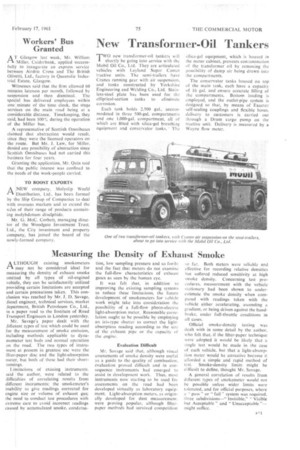Measuring the Density of Exhaust Smoke
Page 45

If you've noticed an error in this article please click here to report it so we can fix it.
LTHOUGH existing smokemeters rA may not be considered ideal for measuring the density of exhaust smoke emitted by all types of oil-engined vehicle, they can be satisfactorily utilized providing certain limitations are accepted and certain precautions taken. This conclusion Was reached by Mr. I. D. Savage, diesel engineer, technical services, market department, British Petroleum Co., Ltd., in a paper read to the Institute of Road Transport Engineers in London yesterday.
Mr. Savage's paper dealt with the different types of test which could be used for the measurement of smoke emission, including methods applicable to dynamometer test beds and normal operation on the road. The two types of instrument at present in greatest use were the illterpaper disc and the light-absorption meter, but both of these had their shortcomings.
Limitations of existing instruments, said theauthor, were related to the difficulties of correlating results from different instruments; the smokemeter's inability to give readings corrected for engine size or volume of exhaust gas; the need to conduct test procedures with extreme care to avoid incorrect readings caused by accumulated smoke, condensa
tione low sampling pressure and so forth: and the fact that meters do not examine the full-flow characteristics of exhaust gases as seen by the human eye.
It was felt that, in addition to improving the existing sampling systems to reduce these limitations, the future development of smokemeters for thick work might take into consideration the possibility of a full-flow photo-electric light-absorption meter. Reasonable correlation ought to he possible by employing an iris-type shutter to correct the lightabsorption reading according io the size of the exhaust pipe or the capacity of the engine, Evaluation Difficult Mr. Savage said that, although visual assessments of smoke density were useful as a guide to the quality of combustion, evaluation proved difficult and in consequence instruments had emerged to assist in development work. Thus, most instruments now starting to be used for assessments on the road had been developed virtually as laboratory equipment. Light-absorption meters, as originally developed for dust measurement, were proving popular, although filterpaper rnetleods had survived competition so far. Both meters were reliable and effective for recording relative densities but suffered reduced sensitivity at high smoke density. Concerning test procedures, measurement with the vehicle stationary had been shown to underestimate the smoke density when compared with readings taken with the vehicle either accelerating, ascending a eradient, or being driven against the handIi rake, under full-throttle conditions in all cases.
Official smoke-density testing was dealt with in some detail by the author, who felt that, if the filter-paper technique were adopted it would be likely that a single lest would be made in the case of each vehicle, but that a fight-absorpiion meter would be attractive because it afforded a simple and rapid method of test. Smoke-density limits might be difficult to define, thought Mr. Savage.
A general correlation of results from different types of smokemeter would not be possible unless wider limits were tolerated, and for official purposes, where a " pass" or " fail" system was required, three subdivisions—" Invisible," " Visible but Acceptable" and " Unacceptable "— might suffice.




















































































































